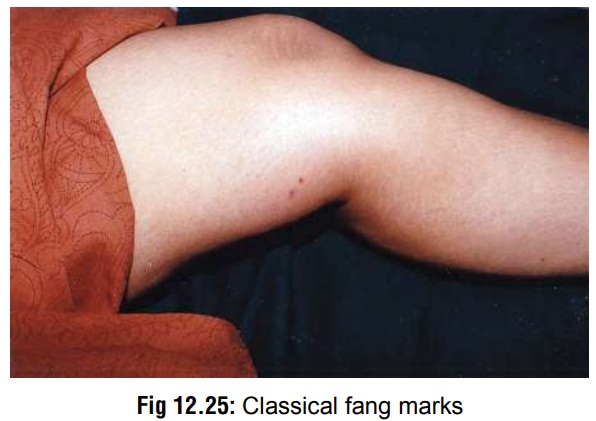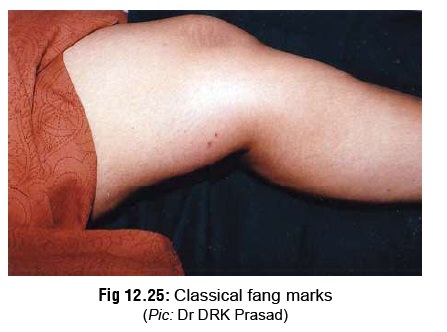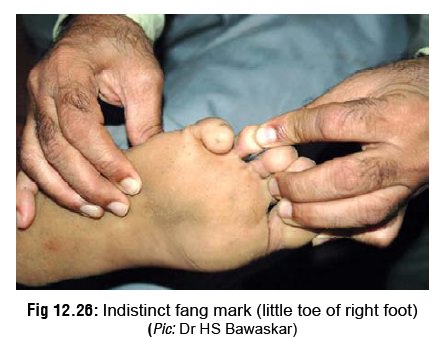Chapter: Modern Medical Toxicology: Organic Poisons (Toxins): Venomous Bites and Stings
Diagnosis of Snakebite

Diagnosis of Snakebite
1. Fang Marks:
Classically, there should be two
puncture wounds (Fig 12.25) which
are separated from each other by a distance varying from 8 mm to 4 cm,
depending on the species involved. However, a sideswipe may produce only a
single puncture, while multiple bites could result in numerous fang marks. It
is also important to remember that many venomous species possess more than one
set of fangs and thus multiple fang marks may be present even in the normal
course.

In
addition, many non-venomous species such as the Common Wolf Snake have large
front teeth which inflict bites that look similar to fang marks.
Occasionally,
fang marks may not be clearly evident (Fig
12.26).

2. Identification of Snake:
a. This is fraught with difficulties as
mentioned earlier, though it can be attempted in those cases where the victim
or his attendants bring with them the culprit (dead) snake.
b. Extreme caution is imperative in this
context: there are instances on record of killed snakes inflicting reflex bites
on being handled! Even a completely severed head is not always innocuous in
this regard.
3. Laboratory Investigations:
a. Haematological—
– Anaemia
– Leucocytosis
– Thrombocytopenia
– High haematocrit initially; later it falls
–
Evidence of haemolysis: fragmented RBC (schis-tocytes or helmet cells)
– Prolonged clotting time and prothrombin time
– Prolonged partial thromboplastin time
– Depressed fibrinogen levels
– Elevated FDP (Fibrin degradation products).
b. ECG—
– Common ECG changes include bradycardia with
ST segment elevation or depression, T wave inversion, QT prolongation, and
changes due to hyperkalaemia.
c.Metabolic—
–
Hyperkalaemia
–
Hypoxaemia with respiratory acidosis
–Metabolic
acidosis or lactic acidosis (increased anion gap).
d. Urine—
–Haematuria
–Proteinuria
– Haemoglobinuria
– Myoglobinuria.
e.Renal—
–In
acute renal failure, all features of azotaemia will be present.
f.Chest
X-ray—
– Pulmonary oedema
– Intrapulmonary haemorrhages
– Pleural effusion.
X-ray
of bitten part—
–
For bitten areas that remain tender, plain radio-graphs may reveal the presence
of embedded snake tooth/fang fragments.
h. Immunodiagnosis—
–
Immunological detection of venom antigens in body fluids can be
accomplished by ELISA. This is highly sensitive, but specificity may be
inadequate to distinguish between different species of snakes.
–
For forensic investigation of death due to snake-bite, methods are being
validated for immunoana-lytical methods of detection of the venom of some
venomous snakes such as cobra and krait from autopsy samples. Enzyme
immunoassay method-ology (IgY-based sandwich ELISA and indirect competitive
inhibition ELISA) has been optimised for the detection of cobra and krait
venom. A new preservant (70% ethanol, 2% glycerol, 28% [0.02 M] PBS, pH 7.4,
and 0.05% thimerosal) is being recommended for preservation of forensic
samples.
Related Topics